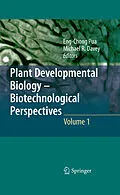Understanding the mechanisms whereby plant development is regulated is crucial for crop improvement using genetic engineering. This work, comprising two volumes, reviews recent advances in plant developmental biology and explores the possibility of their practical applications from biotechnological perspectives.
Volume 1 deals with the plant model and its life cycle. Topics include the formation of shoots, roots, flowers and gametes, pollen germination, fertilization, fruit development and ripening, seed development, dormancy and germination, apomixis, male sterility and self-incompatibility.
Volume 2 focuses on development-related areas, including tissue culture (somatic embryogenesis, microspore embryogenesis, somaclonal variation), plant processes (photosynthesis, seed maturation and seed proteins, fatty acids, vitamins, alkaloids, flower pigments and scent), signalling (amino compound-containing lipids, auxins, cytokinins and light), and molecular genetics of developmental regulation (RNA silencing, DNA methylation, epigenetics, activation tagging, homologous recombination and synthetic promoter engineering).
This work is a key reference for plant breeders, researchers and graduate students in the fields of plant biotechnology, agronomy, horticulture, genetics and functional genomics, and cell and molecular biology.
Zusammenfassung
Many exciting discoveries in recent decades have contributed new knowledge to our understanding of the mechanisms that regulate various stages of plant growth and development. Such information, coupled with advances in cell and molecular biology, is fundamental to crop improvement using biotechnological approaches. Two volumes constitute the present work. The ?rst, comprising 22 chapters, commences with introductions relating to gene regulatory models for plant dev- opment and crop improvement, particularly the use of Arabidopsis as a model plant. These chapters are followed by speci?c topics that focus on different developmental aspects associated with vegetative and reproductive phases of the life cycle of a plant. Six chapters discuss vegetative growth and development. Their contents consider topics such as shoot branching, bud dormancy and growth, the devel- ment of roots, nodules and tubers, and senescence. The reproductive phase of plant development is in 14 chapters that present topics such as ?oral organ init- tion and the regulation of ?owering, the development of male and female gametes, pollen germination and tube growth, fertilization, fruit development and ripening, seed development, dormancy, germination, and apomixis. Male sterility and self-incompatibility are also discussed.
Inhalt
Models for Plant Development.- Gene Regulatory Models for Plant Development and Evolution.- Arabidopsis as Model for Developmental Regulation and Crop Improvement.- Vegetative Growth and Development.- Axillary Shoot Branching in Plants.- Bud Dormancy and Growth.- Root Development.- Legume Nodule Development.- Tuber Development.- Senescence.- Reproductive Growth and Development.- Floral Organ Initiation and Development.- Control of Flower Development.- Development and Function of the Female Gametophyte.- Male Gametophyte Development.- Pollen Germination and Tube Growth.- Fertilization in Angiosperms.- Fruit Development.- Mechanism of Fruit Ripening.- Seed Development.- Seed Dormancy: Approaches for Finding New Genes in Cereals.- Seed Germination.- Apomixis in the Era of Biotechnology.- Male Sterility.- Self-Incompatibility Systems in Flowering Plants.
